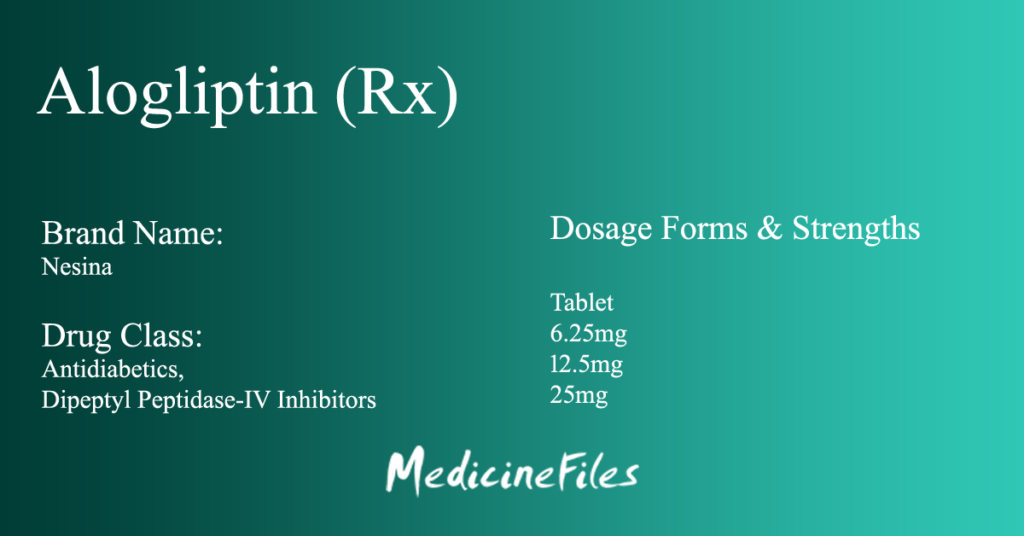Alogliptin, Oral
Alogliptin brand name: Nesina
Drug Class: Antidiabetics, Dipeptyl Peptidase-IV Inhibitors
Table Of Content
- Side effects associated with Alogliptin.
- Warning and Precautions
- What Are Dosages of Alogliptin?
- Brand Names
- Combination Brand Names
- FAQs
What Is Alogliptin and How Does It Work?
Uses
Alogliptin is used together with diet and exercise to improve blood sugar control in adults with type 2 diabetes mellitus. Alogliptin is not for treating type 1 diabetes.
Sometimes, Alogliptin is used in combination with other diabetes medications.
Alogliptin may also be used for purposes not listed in this medication guide.
Description
- Alogliptin is Oral DPP-4 inhibitor given once daily; reduces breakdown of GLP-1 which increases insulin secretion
- Used for type 2 diabetes mellitus in adults; mean A1C reduction 0.4 to 0.6%
- Alogliptin is used as monotherapy or in combination with other hypoglycemic agents including insulin, but not GLP-1 agonists
How should I take alogliptin?
Read the Medication Guide provided by your pharmacist before you start using alogliptin and each time you get a refill. If you have any questions, ask your doctor or pharmacist.
Take this medication by mouth as directed by your doctor, usually once daily with or without food. Take alogliptin at around the same time every day.
Alogliptin controls diabetes but does not cure it. Continue to take alogliptin even if you feel well. Do not stop taking alogliptin without talking to your doctor.
Alogliptin is only part of a treatment program that may also include diet, exercise, weight control, blood sugar testing, and special medical care. Follow your doctor’s instructions very closely.
Alogliptin Side Effects
This medication may cause changes in your blood sugar. You should know the symptoms of high and low blood sugar and what to do if you develop these symptoms.
Alogliptin may cause side effects. Tell your doctor if any of these symptoms are severe or do not go away:
Common side effects of Alogliptin include:
- Headache
- Stuffy or runny nose
- Sore throat
- Joint pain
Serious side effects of Alogliptin include:
- Severe pain in the upper stomach spreading to the back,
- Nausea and vomiting,
- Loss of appetite,
- Fast heart rate,
- Itching,
- Dark urine,
- Clay-colored stools,
- Jaundice (yellowing of the skin or eyes), and
- A severe skin reaction.
Alogliptin may cause other side effects. Call your doctor if you have any unusual problems while taking this medication.
Warnings
Contraindications
- Hypersensitivity to alogliptin, including anaphylaxis, angioedema, or severe cutaneous adverse reactions including Stevens-Johnson syndrome.
- You should not use this medicine if you have diabetic ketoacidosis.
Cautions
Alogliptin can cause serious side effects on your heart or pancreas, especially if you have ever had similar problems, or if you have kidney or liver disease.
Call your doctor right away if you have: signs of pancreatitis–severe pain in your upper stomach spreading to your back; or signs of heart failure–shortness of breath while lying down, weight gain, swelling in your legs or feet.
alogliptin is not for treating type 1 diabetes.
Before taking alogliptin,
You should not use this medicine if you are allergic to alogliptin, or if you have diabetic ketoacidosis (call your doctor for treatment).
Tell your doctor if you have ever had:
-
liver disease;
-
heart disease;
-
kidney disease (or if you are on dialysis);
-
pancreatitis;
-
gallstones; or
-
alcoholism.
Pregnancy and Lactation
Pregnancy
- Pregnancy Category: B (May be acceptable during pregnancy).
Lactation
- Unknown whether distributed in breast milk
What Are Dosages of Alogliptin?
Adult dosage
Tablet
- 6.25mg
- 12.5mg
- 25mg
Diabetes Mellitus Type 2
Adult dosage
- Alogliptin 25 mg tablet orally once daily
Pediatric Dosage
Alogliptin is not approved for use by anyone younger than 18 years old.
Dosing Considerations
Should be Given as Follows:
Limitations of use: Not indicated for the treatment of type 1 diabetes mellitus or diabetic ketoacidosis, as it would not be effective in these settings
Assess renal function before initiating alogliptin and periodically thereafter
Alogliptin brand name
Brand names of combination products
- Kazano® (containing Alogliptin, Metformin)
- Oseni® (containing Alogliptin, Pioglitazone)
FAQs
How does Alogliptin interact with other medications?
Alogliptin can interact with other medications, so it is important to inform your healthcare provider about all the medications you are taking, including over-the-counter drugs, vitamins, and herbal supplements.
What should I avoid while taking Alogliptin?
Avoid alcohol as it can affect blood sugar levels.
What should I do if I missed a dose?
If you miss a dose of Alogliptin, take it as soon as you remember. If it is almost time for your next dose, skip the missed dose and continue with your regular schedule. Do not take two doses at the same time.
What happens if I overdose?
Seek emergency medical attention or call the Poison Help line at 1-800-222-1222. You may have signs of low blood sugar, such as extreme weakness, blurred vision, sweating, trouble speaking, tremors, stomach pain, confusion, and seizure (convulsions).


